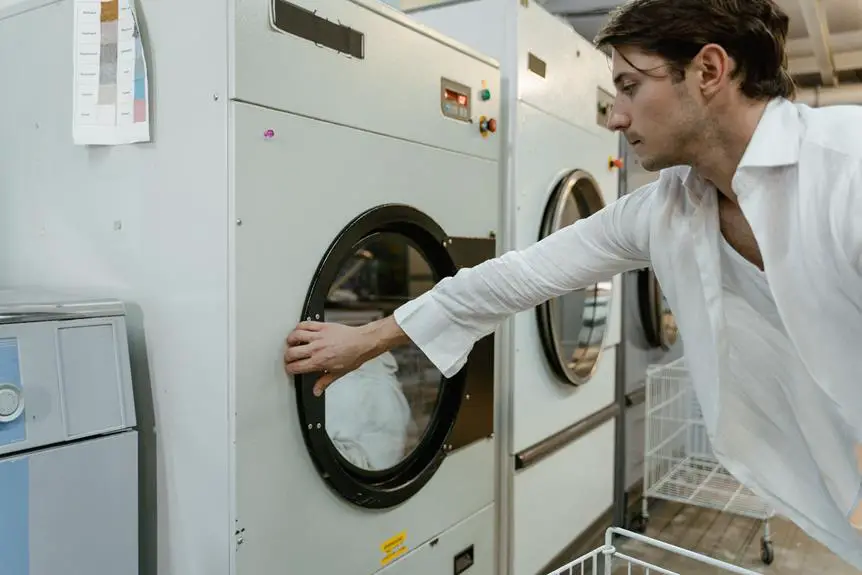If your Amana dryer isn't drying clothes properly, it's important to identify and resolve the issue.
Start by cleaning the lint screen to ensure proper airflow.
Next, examine the exhaust vent for any blockages or damage that could be affecting the dryer's performance.
Check the outside vent hood for any obstructions as well.
Consider whether you are using auto-dry or timed-dry settings, as they can impact drying times.
Make sure the dryer drum isn't overloaded, and verify that the heating element and thermostat are working correctly.
If these steps don't fix the problem, you may need to consult a technician for further assistance.
Checking the Lint Screen
A clogged lint screen can reduce the efficiency of an Amana dryer and pose a fire risk. The screen, located on the top or inside the door, should be cleaned after each use to prevent lint buildup and maintain airflow. If the screen is blocked, the dryer works harder, increasing drying times and energy use. Heat buildup from a clogged screen can also damage clothes and the dryer.
For optimal performance and safety, regularly clean the dryer vent by disconnecting the hose from the dryer and the wall to remove lint. Clear airflow reduces restrictions and improves dryer efficiency. Regular maintenance can enhance drying performance and prolong the life of the dryer.
Inspecting the Exhaust Vent
Inspect the exhaust vent of your Amana dryer after cleaning the lint screen. A clogged vent can reduce dryer efficiency, leave clothes damp, and is a fire hazard.
Check the outside exhaust hood for blockages. If there is lint buildup, remove it with a cleaning brush or vacuum. Use images or a test kit to check for hidden clogs.
The vent should be made of rigid or flexible metal for best airflow; avoid foil or plastic materials. Clean the vent at least once a year, or more often if dryer performance drops.
Proper maintenance ensures efficient drying, prolongs the dryer's life, and enhances home safety.
Analyzing the Vent Hood
The vent hood of an Amana dryer is crucial for expelling moist air and supporting efficient drying. A blocked vent hood, often due to lint accumulation, can cause longer drying times and increase the risk of fire.
To ensure the vent hood functions properly, it should be checked regularly for lint buildup and cleared to maintain air flow. Additionally, the vent hood's flapper door must be able to open freely to prevent overheating and excess humidity inside the drum, which can hinder drying.
If the vent hood is not the issue, the next step is to examine the dryer's thermostats and flame sensors for faults, as these can also affect drying performance. Odd noises or smells during use may indicate problems with these components.
Should the dryer still perform poorly after addressing the vent hood and other parts, professional repair or replacement might be necessary, especially if the dryer is over ten years old.
Understanding Auto Vs. Timed Dry
Choosing the right drying cycle on your Amana dryer is crucial for effective and energy-efficient operation.
Auto Dry uses sensors to adjust the drying time based on the clothes' moisture levels, preventing over-drying and saving energy.
Timed Dry runs for a set period, which can lead to either damp clothes or over-drying, possibly damaging delicate items.
For best results and garment care, use Auto Dry. It dries clothes properly without extra effort or energy waste, contributing to the durability of your clothes and dryer.
Assessing Load Size
Overloading an Amana dryer reduces its efficiency. A full load limits clothing movement, causing longer drying times and potentially wet clothes after the cycle. For optimal performance, check the load size before drying.
Ensure the dryer drum is no more than three-quarters full to allow clothes to tumble and air to circulate properly. Overfilling the dryer can increase drying times and strain the machine, which may lead to malfunctions.
If clothes are often damp post-drying, consider smaller loads for more effective drying and to avoid running multiple cycles, which wastes time and energy. Remember that heavy items like towels and blankets need more space and may require their own cycle.
To maintain your Amana dryer's efficiency and properly dry clothes, it is important to manage the load size carefully.
Troubleshooting the Heating Element
Test the Amana dryer's heating element with a multimeter for continuity to determine if replacement is necessary. Extended drying times may indicate a malfunctioning heating element. Before troubleshooting, unplug the dryer to avoid electrical hazards. Follow the manufacturer's instructions to access the element, usually involving removing the back panel. Check the element with a multimeter; a lack of continuity suggests the need for a new heating element.
Lint build-up can also hinder the heating element's performance. Clean the lint filter and the internal vent regularly to prevent blockages and ensure proper airflow. Check the blower wheel, as it aids in air circulation; a faulty blower wheel can affect drying.
Examining the Thermostat
A malfunctioning thermostat in an Amana dryer can cause poor drying performance by not properly controlling temperature. This component is essential for regulating heat in the dryer drum. If the thermostat fails, it might not activate the heating element or might turn it off too soon, resulting in air that's not hot enough to dry clothes effectively. To enhance air flow and thermostat function, regularly clean the exhaust hood and check for blockages in the dryer's flexible metal duct.
Before inspecting the thermostat, disconnect the dryer's power and access the thermostat housing through the door opening. Indicators of a malfunctioning thermostat include strange noises or odors during dryer operation, suggesting incorrect temperature regulation.
For troubleshooting a thermostat, refer to the user manual of the specific Amana dryer model to learn how to test the thermostat with a multimeter. If the thermostat lacks continuity or the resistance is incorrect, replacement may be necessary. If you are unsure about performing these tests, it is safer to hire a professional technician to evaluate and possibly replace the defective thermostat.



